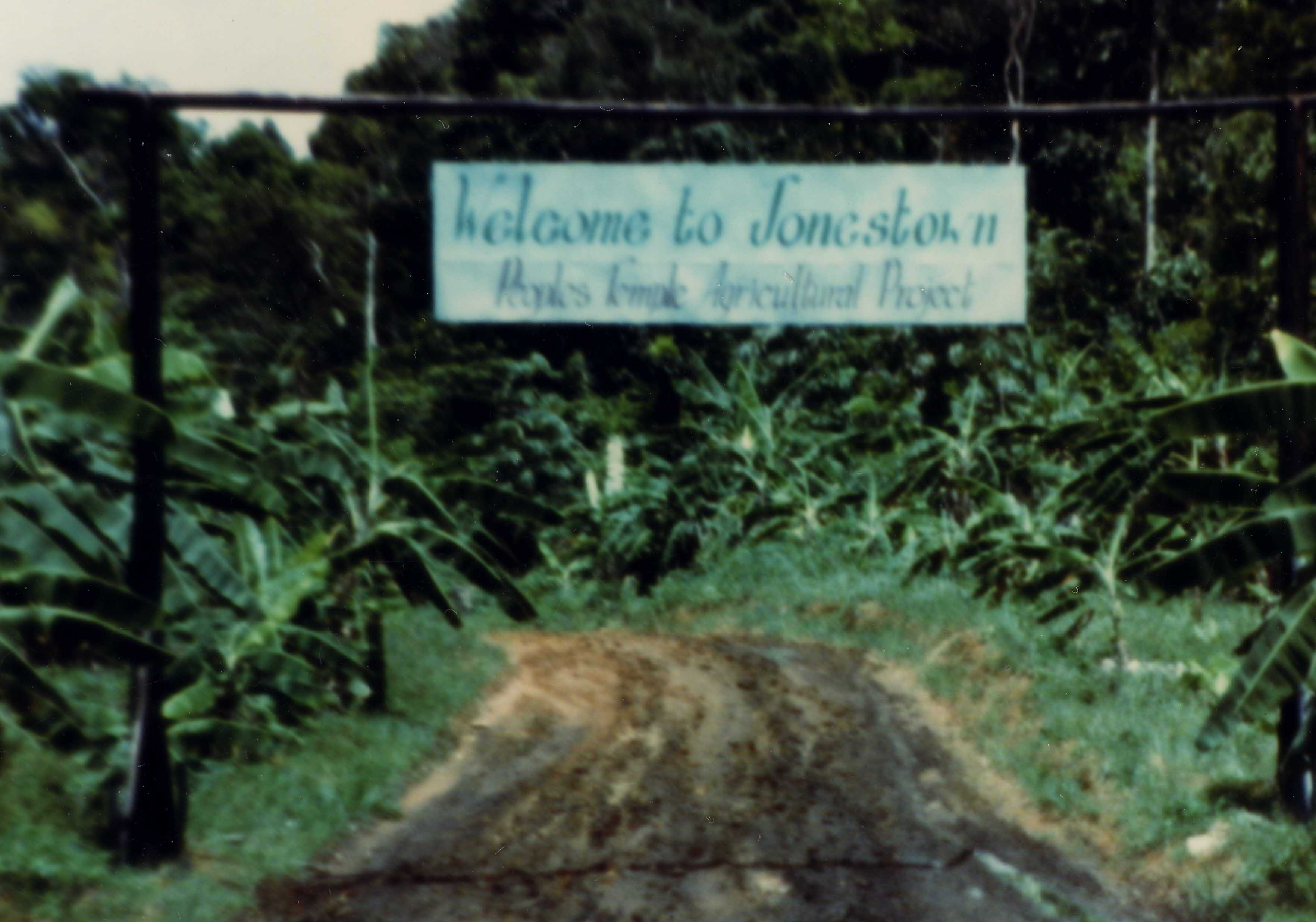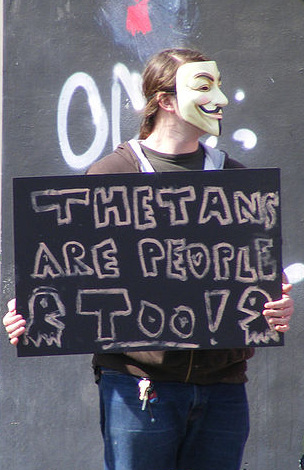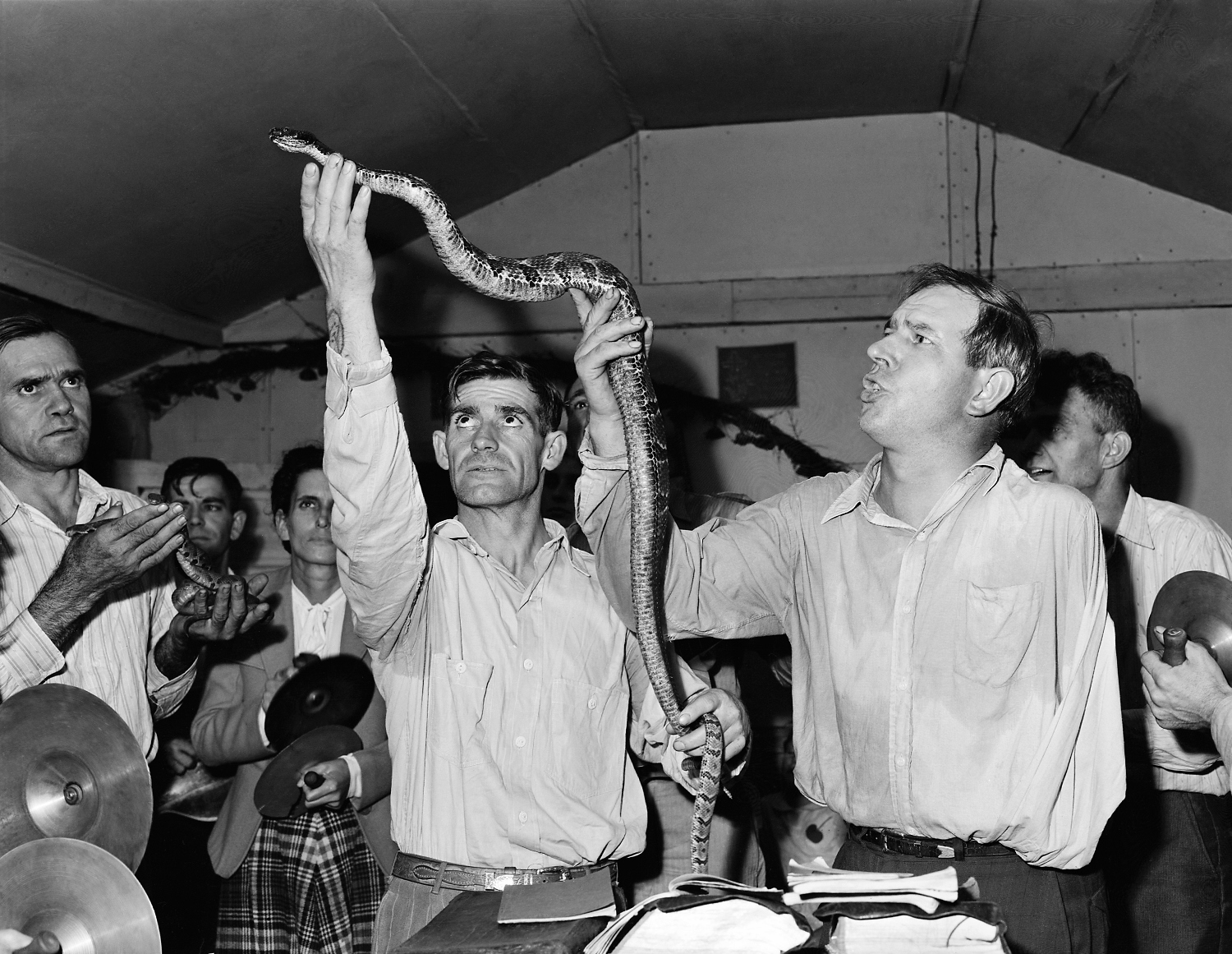Everything New is Old Again: New Religious Movements as American Minority Religions
This article situates the teaching of new religious movements (NRMs) within the scope of scholarship on American minority religions. In the course that serves as my primary example, readings and class discussions considered 20th century NRMs in light of American enthusiasms for—and anxieties about—shifting attitudes toward race, gender, class, and sexuality, particularly since the 1940s. Assignments included unconventional approaches to working with primary sources and student creations of hypothetical new religions, contextualized within NRM members’ experiences of support and scorn by mainstream legal, media, and popular culture sources. Students noted key similarities in intolerant rhetoric toward American minority religions, examined challenges specific to radical religious innovation in an American framework, and challenged the primacy of “newness” in the study of marginal American religiosity.
![Teaching American minority religions through the lens of religious intolerance. Image: Cover of sheet music for the song, "We are all Klansmen" (1923). By Bcrowell at en.wikipedia [Public domain], from <a target="_blank" href="http://commons.wikimedia.org/wiki/File:Klan-sheet-music.jpg">Wikimedia Commons</a>](http://rsn.aarweb.org/sites/default/files/Spotlight%20on%20Teaching/Fall%202014/Klan-sheet-music.jpg)
This spring, I taught an advanced intermediate course on American minority religions at Elon University, a private liberal arts university in the American South. While roughly half of the traditions covered by the course lie within the murky boundaries of “new religious movements,” I wanted to concentrate on the marginality, rather than the novelty, of the traditions in question. I adopt a similar approach in my research, which focuses on the prevalent suspicions of sexual abuse and exploitation faced by minority religious communities, especially their women and children members. Because I wanted the students to focus on the power implicit in the act of defining religion—and particularly in the exclusion of specific religious beliefs, practices, and people from the category of American religion—I used religious intolerance (see Neal 2010) as the primary approach to this topic. I encouraged the class to consider key similarities among popular responses to and condemnations of minority religious beliefs and practices, particularly since the early century. I attempted to disrupt students’ understandings of what (and who) makes for “normal” or “real” or “true” American religion(s), and why those distinctions matter.
Designing this syllabus presented two key challenges. First, who were we talking about when we talked about “minority religions?” Second, how were we to understand the category of “minority?”
Locating American Minority Religions
Drawing heavily on primary source material (Corrigan and Neal 2010), I tried to show my students that the suspicions, challenges, and concerns minority religions face are not unique to sects, cults, or emergent religious movements. Groups the American mainstream now widely recognizes as bona fide Religion have in recent decades encountered accusations of disingenuousness, irrationality, coerciveness, sexual misconduct, and the disruption of good order within the American body politic (see Davis 1960). These same suspicions plague modern radical religious innovators, both within and beyond established traditions. Thus the class’s guiding hypothesis was that the marginality of minority religions owed less to the movements’ novelty than to their failure to approximate mainstream Protestant beliefs and practices.

For this reason, I divided the class into four sections. We spent the first quarter defining “American religion” as a category and discussing how best to understand minority within that category (about which more in the following section). The second quarter explored what I called “mainstream minority religions”: Indigenous religions; Judaism; Islam; and Roman Catholicism. Given my university’s large concentration of Roman Catholic students, class members found the idea of disenfranchised Catholicism hard to fathom. But American Roman Catholicism served as a trenchant example of a formerly maligned minority religion now accepted as mainstream by the American public. I assigned Kennedy’s 1960 speech to the Greater Houston Ministerial Association to illustrate American Catholicism’s lingering foreignness well into the 20th century.
I intentionally began with more familiar and better established minority traditions to establish the terms on which we would discuss subsequent traditions. As our primary sources illustrated, each tradition faced popular suspicions of sexual predation or perversion, sedition, and similar allegations that would likewise plague subsequent, less familiar movements.
The third quarter of the semester focused on innovations within mainstream Protestantism(s), primarily Pentecostalism, charismatic Christianities, and evangelicalisms. It was at this point that students began describing their literary interlocutors as “weird,” “crazy,” or otherwise suspect. We returned often to the texts, identifying the scriptural precedents and internal logic to contextualize practices and beliefs the students found strange and sometimes unsettling. For their midterm assignment, the class as a whole curated an imaginary museum exhibit using correspondence, news articles, census data, and images pertinent to the Azusa Street revival. Engaging both the biblical precedents for charismatic Christianity and the intramovement discourse helped humanize and contextualize unfamiliar practices and foregrounded the role race and class played in popular condemnations of early American Pentecostalism.
At the semester’s midpoint, we moved from Pentecostalism primary sources to Dennis Covington’s ([1995] 2009) Salvation on Sand Mountain. We paired Covington’s account of Appalachian Signs Following congregations with Robert Orsi’s chapter “Snakes Alive: Religious Studies Between Heaven and Earth”(2005). This conversation in particular surfaced concerns and rhetoric about the rationality of minority belief and practice. As with Pentecostalism and other charismatic Christianities, we considered issues of biblical literalism—here, literal interpretations of Mark 16:15-20, which Signs Following Christians interpret as promising immunity to serpents’ venom (among other signs) as proof of conviction. We debated the merits of Orsi’s “suspensive” approach to religious studies, which challenges scholars to move beyond “otherizing,” denying, or redeeming such unfamiliar practices and acknowledge the material realities of lived religious difference (2005, 202–3).

We drew upon this approach often throughout the final quarter of the semester, which explored radical American religious innovation. In particular, David Chidester’s excellent “Rituals of Exclusion and the Jonestown Dead” (1988) helped students understand and articulate the logic underlying unsettling NRM theologies like those of Jim Jones, David Koresh, and Tom Cruise. The latter might sound like a facetious inclusion, but one of our more productive close reading exercises put Tom Cruise’s motivational Scientology video (made infamous by Gawker) in conversation with the Church’s public statement on theology and practice. Though students initially dismissed Cruise’s passionate monologue as “insane” and “bizarre,” critical reading of the Church’s creed demonstrated that—while Cruise’s manner might be off-putting—his statements were firmly grounded in Scientological canon. This exercise stands out in part because my students, mostly juniors and seniors, struggled far more with critical reading practices than I had anticipated. I will return to considerations of critical reading in the conclusion of this article.
The Making of Minority
The second challenge in designing this class was to define the category of minority within American religion. As I noted above, I wanted to emphasize the marginality, not the novelty, of the movements in question. My own work interrogates articulations of religious intolerance grounded in assumptions about normative American sexuality. Such assumptions intersect, build on, and reinforce gender, racial, and class norms. For this reason, the class categorized the conditions of movements’ marginalization in terms of systemic inequalities among America’s races, classes, genders, and sexualities. Cultural norms about race, class, gender, and sexuality draw on and reinforce conditions that perpetuate systemic inequalities that privilege white/male/well-educated/affluent/heterosexuality. “American religion” both responds to and reinscribes inequality by conflating these conditions of privilege with mainline Protestantism(s) (cf. Jakobsen and Pellegrini 2004; Fessenden 2007; Sullivan 2005).
![Not shown: religious minorities. Not shown: religious minorities. Image: Fair in Rutland, Vermont, September 1941. By Jack Delano, for the Office of War Information [Public domain], via <a target="_blank" href="http://commons.wikimedia.org/wiki/File%3AFreak_show_1941.jpg">Wikimedia Commons</a>.](http://rsn.aarweb.org/sites/default/files/Spotlight%20on%20Teaching/Fall%202014/Freak_show_1941.jpg)
I wanted my students to understand that it is no small thing to dismiss a religious person as irrational or a religious practice as abnormal simply for failing or refusing to approximate mainstream Protestant attitudes. To adapt R. Laurence Moore (1986, x), Americans’ willingness to “ignore, or treat as sideshow events” the beliefs, practices, material culture, and aspirations of non-white, non-male, non-affluent, non-conventionally procreative-heterosexual non-mainline-Protestants perpetuates social inequality. Thus the message of this class: there is no race-, gender-, class-, or sexuality-neutral definition of American religion. Defining American religion—what the American public tolerates and what it will not abide as religious—is in itself a political act (Bivins 2008, 6; Orsi 2005, 202–3). And the ability to delimit and enforce that definition is an articulation of power.
Thus my class categorized minority religions as those traditions and people who had less access than mainstream (white, straight, middle-to-upper class, well-educated, male) Protestants to material wealth, representation in government, legal protections, and public respectability. By engaging tradition-specific case studies, students discovered that throughout American history, radical religious innovation has often targeted at least one of these systemic inequalities. Students further explored the vast disparity among minority traditions’ attempts to correct or restore proper gender, sexual, class, and/or race relations.
![A version of Sam Killerman’s Genderbread Person A version of Sam Killerman’s Genderbread Person. [Public Domain] via <a target="_blank" href="http://itspronouncedmetrosexual.com/2012/03/the-genderbread-person-v2-0/">It's Pronounced Metrosexual</a>.](http://rsn.aarweb.org/sites/default/files/Spotlight%20on%20Teaching/Fall%202014/424px-Gender_Gingerbread.svg.png)
Early in the semester, I needed to establish race, gender, sexuality, and class as categories of analysis in the study of American religions. In previous semesters, I’ve used canonical works to start these conversations: Peggy McIntosh’s Invisible Knapsack, Dorothy Allison’s “Question of Class,” Michel Foucault’s History of Sexuality. (I was never quite brave enough to try teaching Judith Butler to undergraduates.) These are brilliant and important works, but undergraduate conversations about them often get bogged down in peripherals: my mostly-white students dwelled on the idea that their classmates of color can’t buy flesh-colored bandages that match their own skin tones; Allison’s account is moving and stark but alienates students not conversant with LGBTQ literature or queer theory; Foucault’s language can be overwhelming and obscure for the novice. I took a different approach this time. I used popular writings—smart blog posts, mostly—to introduce these categories. My approach was not nuanced or detailed, but these pieces hit home in a way the more traditional assignments never had. In particular, Sam Killerman’s (2013) The Social Justice Advocate’s Handbook: A Guide to Gender was a compelling way to acquaint students with the concepts of privilege, social justice, and systemic oppression.
Subsequent readings examined minority religious discourse from within and without. Primary sources gave us a sense of what movements were saying about their own beliefs, practices, desires, and commitments, as well as how surrounding communities responded to the groups’ innovations. Students read memoirs and newspaper clippings, watched newsreels and documentaries and South Park, and critiqued spoken word and musical theater numbers. Each session also included a scholarly analysis of the tradition in question. For example, Tisa Wenger’s (2005) outstanding article, “We Are Guaranteed Freedom,” demonstrated the political deployment of the category of religion during our session on Indigenous religions. Nuanced and accessible, this piece did a far better job of disrupting students’ assumptions about religion as a native category than three previous weeks of my explanations had managed. My experiences suggest that, at least at an introductory level, students grasp abstract concepts more quickly through concrete examples of lived oppressions than through the more nuanced theoretical texts themselves.
Re-Making the American Religious Fringe
I’ll be teaching an introductory/intermediate version of this class in the fall. As I approach my revisions, two design points stand out as in need of improvement.
Thinking Smaller
My enthusiasm for the material superseded pedagogical moderation. This was a great group, and the students learned a lot, but I tried to do too much in too short a time. The course had no prerequisites, and class members had vastly different levels of preparation and familiarity with American history and religious and cultural studies. Students with humanities backgrounds fared well, but my business majors and scientists struggled more than I expected with some basic concepts (like the social construction of race, or that religion is more than their personal feelings about God). This coming semester I plan to discuss race and class but will forefront gender and sexuality as our primary analytical lenses.

In a similar vein, students’ inconsistent knowledge of contemporary American history—their relative ignorance about the Cold War, the Civil Rights Movement, and the like—slowed our conversations down more than I had anticipated. With this in mind, I intend to focus on the interactions between minority religions and the American public since 1945. I’m hoping that limiting the historical scope of the course will allow a more in-depth engagement with a likewise reduced number of traditions. (The one tradition that will absolutely remain, however, is Scientology. Student evaluations consistently ranked Scientology as the most interesting thing my class learned about all semester.) By reducing the number of traditions and shortening the scope of the class, I am creating space in our schedule to provide lectures on much needed historical context.
Reading Better
I made unfounded assumptions about the reading practices and abilities of my students while designing this syllabus. While I expected to fill in the gaps around major events in US history and anticipated the class’s unfamiliarity with most of the traditions, I was unprepared for their lack of critical reading skills. This is not a complaint, neither a jeremiad against No Child Left Behind nor an indictment of this particular university, but merely a practical observation. I needed to teach these students how to read at a college level—how to differentiate between what the author is saying, what ze wants the reader to think, what ze wants the reader to do, and why this message matters.
![Mainstream media coverage of the Azusa Street Revival Mainstream media coverage of the Azusa Street Revival. [Public domain] via <a target="_blank" href="http://commons.wikimedia.org/wiki/File%3A026_la_times.gif">Wikimedia Commons</a>.](http://rsn.aarweb.org/sites/default/files/Spotlight%20on%20Teaching/Fall%202014/026_la_times.gif)
Most of my students had little to no experience working with primary source materials, which again made for unanticipated challenges—particularly given the course’s emphasis on religious intolerance. Unless a piece appeared in our documentary history reader, it often never occurred to most students that the author might be biased against the tradition in question. Several students consistently took at their word what I thought were obviously and grossly biased accounts of minority religious beliefs and practices. I had to explain that all newspapers were not automatically trustworthy accounts of actual events. Moving forward, I want to spend more time deliberately developing those critical skills and helping students learn to become more thoughtful, careful readers of both primary and secondary sources, perhaps through low-stakes critical reading exercises early in the semester. In short, I hope to do more with less material, while maintaining the same focus on the privilege and power at work in defining American minority religions.
Resources
Corrigan, John, and Lynn S. Neal. 2010. Religious Intolerance in America: A Documentary History. Chapel Hill, NC: University of North Carolina Press.
Bivins, Jason C. 2008. Religion of Fear: The Politics of Horror in Conservative Evangelicalism. New York, NY: Oxford University Press.
Chidester, David. 1988. “Rituals of Exclusion and the Jonestown Dead.” Journal of the American Academy of Religion 56, (4): 681–702.
Covington, Dennis. (1995) 2009. Salvation on Sand Mountain: Snake Handling and Redemption in Southern Appalachia. Reprint. Philadelphia, PA: De Capo.
Davis, David Brion. 1960. “Some Themes of Counter-Subversion: An Analysis of Anti-Masonic, Anti-Catholic, and Anti-Mormon Literature.” The Mississippi Valley Historical Review 47 (2): 205–224. http://www.jstor.org/stable/1891707
Fessenden, Tracy. Culture and Redemption: Religion, the Secular, and American Literature. Princeton, NJ: Princeton University Press, 2011.
Jakobsen, Janet R., and Ann Pellegrini. (2004). Love the Sin: Sexual Regulation and the Limits of Religious Tolerance. Boston, MA: Beacon Press.
Killerman, Sam. 2013. The Social Justice Advocate's Handbook: A Guide to Gender. Austin, TX: Impetus Books.
Melton, J. Gordon. 2007. “Perspective: New New Religion: Revisiting a Concept.” Nova Religio: The Journal of Alternative and Emergent Religions 10 (4): 103–112.
Moore, R. Laurence. 1986. Religious Outsiders and the Making of Americans. New York, NY: Oxford University Press.
Neal, L.S. 2010. “Intolerance and American Religious History.” Religion Compass 4 (2): 114–123. doi: 10.1111/j.1749-8171.2009.00192.x
Orsi, Robert A. 2005. “Snakes Alive: Religious Studies between Heaven and Earth.” In Between Heaven and Earth: The Religious Worlds People Make and the Scholars Who Study Them. Princeton, NJ: Princeton University Press.
Wenger, Tisa. 2005. “We Are Guaranteed Freedom: Pueblo Indians and the Category of Religion in the 1920s.” History of Religions 45 (2): 89–113.
Winston, Diane. July 3, 2009. “Texas Court Rules Against Polygamist Raid.” Religion Dispatches. http://religiondispatches.org/texas-court-rules-against-polygamist-raid/
Sullivan, Winnifred Fallers. 2005. The Impossibility of Religious Freedom. Princeton, NJ: Princeton University Press.
Megan Goodwin is the 2014–2016 Mellon postdoctoral fellow in pedagogical innovation for the Department of Religious Studies at Bates College. She earned her doctorate in religion and culture at the University of North Carolina at Chapel Hill in 2013 and is the coeditor of the Religions in the Americas section of Religion Compass. Her research emphasizes minority religions, gender, and sexuality, with particular attention to the ways normative sexuality shapes contemporary American religious and national identity. Her article on the role of sexual and religious panic in perpetuating ritual abuse discourse during the 1980s is forthcoming in Literature and Medicine.
Header Image: Snake handling at Pentecostal Church of God, Lejunior, Harlan County, Kentucky, September 15, 1946 (National Archives and Records Administration ARC Identifier 541335). Photo by Russell Lee. In the Public Domain.

